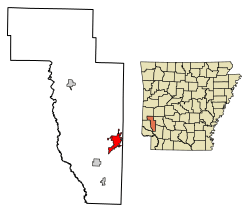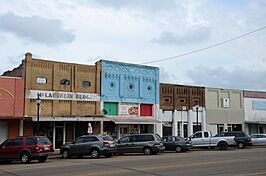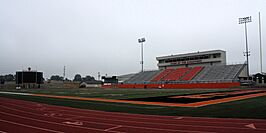Nashville, Arkansas facts for kids
Quick facts for kids
Nashville, Arkansas
|
||
|---|---|---|
|
Clockwise from top: Nashville Commercial Historic District, Howard County Courthouse, Flavius Holt House, Scrapper Stadium at Nashville High School, Howard County Museum, Nashville City Hall
|
||
|
||
| Motto(s):
"Sharing the Hometown Feeling"
|
||

Location of Nashville in Howard County, Arkansas.
|
||
| Country | United States | |
| State | Arkansas | |
| County | Howard | |
| Area | ||
| • Total | 5.52 sq mi (14.29 km2) | |
| • Land | 5.47 sq mi (14.17 km2) | |
| • Water | 0.04 sq mi (0.12 km2) | |
| Elevation | 400 ft (100 m) | |
| Population
(2020)
|
||
| • Total | 4,153 | |
| • Density | 759.09/sq mi (293.11/km2) | |
| Time zone | UTC-6 (CST) | |
| • Summer (DST) | UTC-5 (CDT) | |
| ZIP code |
71852
|
|
| Area code(s) | 870 | |
| FIPS code | 05-48560 | |
| GNIS feature ID | 2404349 | |
Nashville is a city in Howard County, Arkansas, United States. In 2020, about 4,153 people lived there. It is the main city and county seat of Howard County.
Nashville is located at the bottom of the Ouachita foothills. It used to be a big center for growing peaches in southwest Arkansas. Today, the land is mostly used for raising cattle and chickens. In 1983, the world's largest collection of dinosaur footprints was found near the town.
Contents
History of Nashville
A church called Mine Creek Baptist Church was built around 1835 near where Nashville is now. Settlers later created a post stop in 1840. A post office officially opened in 1848. Michael Womack, who was from Tennessee, settled here in 1849. Locals called the area "Mine Creek."
The town grew slowly, especially during the Civil War. After the war, things got better. Nashville officially became a town on October 18, 1883. D.A. Hutchinson was the first mayor. Michael Womack suggested the name, naming it after Nashville, Tennessee.
In 1884, Nashville and Hope were connected by railroad. This helped the town grow even more. The county government moved from Center Point to Nashville. By 1900, Nashville had 928 people. It had cotton factories and a bottling plant. By 1920, the population reached 2,144.
Before the Great Depression, Nashville was a busy town. It had banks, electric lights, waterworks, and factories. It also had good streets and modern schools.
On May 10, 2015, a strong tornado hit the town. Two people sadly lost their lives.
Geography and Climate
Nashville is in the southeastern part of Howard County. Major roads like U.S. Routes 278 and 371 pass through the city. These roads connect Nashville to other nearby towns.
The city is in a valley near Mine Creek. This creek flows south into the Saline and Little rivers. Nashville covers about 5.5 square miles (14.7 square kilometers). Only a small part of this area is water.
Local Climate
Nashville has a humid subtropical climate. This means it has hot, humid summers. The winters are usually mild to cool.
| Climate data for Nashville, Arkansas (1991–2020 normals, extremes 1899–present) | |||||||||||||
|---|---|---|---|---|---|---|---|---|---|---|---|---|---|
| Month | Jan | Feb | Mar | Apr | May | Jun | Jul | Aug | Sep | Oct | Nov | Dec | Year |
| Record high °F (°C) | 84 (29) |
85 (29) |
90 (32) |
92 (33) |
97 (36) |
107 (42) |
107 (42) |
113 (45) |
110 (43) |
101 (38) |
87 (31) |
81 (27) |
113 (45) |
| Mean daily maximum °F (°C) | 54.0 (12.2) |
58.5 (14.7) |
66.5 (19.2) |
74.7 (23.7) |
81.7 (27.6) |
89.3 (31.8) |
93.4 (34.1) |
93.9 (34.4) |
87.9 (31.1) |
77.2 (25.1) |
65.1 (18.4) |
56.4 (13.6) |
74.9 (23.8) |
| Daily mean °F (°C) | 42.9 (6.1) |
46.7 (8.2) |
54.3 (12.4) |
62.1 (16.7) |
70.8 (21.6) |
78.6 (25.9) |
82.4 (28.0) |
82.1 (27.8) |
75.7 (24.3) |
64.3 (17.9) |
53.1 (11.7) |
45.3 (7.4) |
63.2 (17.3) |
| Mean daily minimum °F (°C) | 31.7 (−0.2) |
35.0 (1.7) |
42.1 (5.6) |
49.5 (9.7) |
59.8 (15.4) |
68.0 (20.0) |
71.4 (21.9) |
70.3 (21.3) |
63.5 (17.5) |
51.4 (10.8) |
41.0 (5.0) |
34.3 (1.3) |
51.5 (10.8) |
| Record low °F (°C) | −12 (−24) |
−14 (−26) |
8 (−13) |
23 (−5) |
36 (2) |
46 (8) |
54 (12) |
51 (11) |
30 (−1) |
24 (−4) |
12 (−11) |
−5 (−21) |
−14 (−26) |
| Average precipitation inches (mm) | 3.95 (100) |
4.24 (108) |
5.05 (128) |
5.74 (146) |
6.15 (156) |
4.24 (108) |
4.10 (104) |
3.18 (81) |
3.74 (95) |
5.02 (128) |
4.44 (113) |
5.12 (130) |
54.97 (1,396) |
| Average snowfall inches (cm) | 1.2 (3.0) |
1.0 (2.5) |
0.1 (0.25) |
0.0 (0.0) |
0.0 (0.0) |
0.0 (0.0) |
0.0 (0.0) |
0.0 (0.0) |
0.0 (0.0) |
0.0 (0.0) |
0.0 (0.0) |
0.3 (0.76) |
2.6 (6.6) |
| Average precipitation days (≥ 0.01 in) | 10.1 | 10.3 | 10.9 | 9.5 | 10.3 | 8.2 | 7.5 | 6.9 | 6.3 | 7.8 | 9.0 | 9.9 | 106.7 |
| Average snowy days (≥ 0.1 in) | 0.3 | 0.6 | 0.1 | 0.0 | 0.0 | 0.0 | 0.0 | 0.0 | 0.0 | 0.0 | 0.0 | 0.2 | 1.2 |
| Source: NOAA | |||||||||||||
Population Data
| Historical population | |||
|---|---|---|---|
| Census | Pop. | %± | |
| 1880 | 172 | — | |
| 1890 | 810 | 370.9% | |
| 1900 | 928 | 14.6% | |
| 1910 | 2,374 | 155.8% | |
| 1920 | 2,144 | −9.7% | |
| 1930 | 2,469 | 15.2% | |
| 1940 | 2,782 | 12.7% | |
| 1950 | 3,548 | 27.5% | |
| 1960 | 3,579 | 0.9% | |
| 1970 | 4,016 | 12.2% | |
| 1980 | 4,554 | 13.4% | |
| 1990 | 4,639 | 1.9% | |
| 2000 | 4,878 | 5.2% | |
| 2010 | 4,627 | −5.1% | |
| 2020 | 4,153 | −10.2% | |
| U.S. Decennial Census | |||
2020 Census Information
In 2020, there were 4,153 people living in Nashville. These people lived in 1,733 households, which included 1,085 families.
| Race | Number | Percentage |
|---|---|---|
| White (non-Hispanic) | 1,726 | 41.56% |
| Black or African American (non-Hispanic) | 1,391 | 33.49% |
| Native American | 8 | 0.19% |
| Asian | 49 | 1.18% |
| Pacific Islander | 3 | 0.07% |
| Other/Mixed | 179 | 4.31% |
| Hispanic or Latino | 797 | 9.19% |
Economy and Farming
Peach farming was very important for Nashville, especially during the Great Depression. The peach industry started here in the late 1800s. The best years for peach production were from the 1920s to the 1950s. In 1950, Nashville produced over 400,000 bushels of peaches from 425 orchards. Up to 175 train cars of peaches were shipped out each day!
However, bad weather in 1952 and 1953 destroyed many peach crops. Two-thirds of the peaches were lost. This made it hard for farmers in Howard County. Many had to remove their peach trees. They started using the land for other things, like raising cattle or chickens. Today, cattle and chickens are the main farm products in the Nashville area.
Even though the peach industry isn't as big as it once was, some small peach orchards are still run by local families.
Arts and Culture
Museums and Local Sights
Nashville has several places that are important for their history. These places are listed on the National Register of Historic Places.
- The First Christian Church building was built in the early 1900s. It has a Gothic Revival style and is still an active church.
- The Howard County Museum is located in the First Presbyterian Church building. This building was built in the early 1900s in the Eastlake style.
- Garrett Whiteside Hall is part of the old Nashville High School complex from the 1930s. It is now used for storage and special school events.
- The Elbert W. Holt House and Flavius Holt House are Colonial Revival style homes. They are still used as private houses.
- The Howard County Courthouse is one of the few public buildings in Arkansas built in the Moderne or Art Deco style.
Dinosaur Discoveries
In 1983, the largest collection of dinosaur footprints in the world was found near Nashville. A student named Brad Pittman found these footprints in a quarry north of town. The quarry was once a prehistoric beach.
Thousands of footprints from sauropods (long-necked dinosaurs) were found. They were in a layer of mudstone. Large copies of these footprints, some 65 feet long, were made. They are on display at the Nashville City Park. Many original tracks are in local museums. The full area of the footprints has never been fully dug up.
Education in Nashville
Colleges and Universities
Nashville has a campus of the Cossatot Community College of the University of Arkansas. The college opened a new building in 2006. It offers programs in many areas. These include business, nursing, truck driving, and welding. The college also helps adults get their GED and learn English.
High Schools
Nashville High School is a public school for students in grades 10 to 12. It is managed by the Nashville Public School District. In the 2006–07 school year, it had 390 students and 43 teachers.
In 2010, the Nashville Junior High School Quiz Bowl team won the National Championship. The High School Quiz Bowl team won the State 4A Championship in 2012.
Nashville High School also has many clubs. These include FCCLA, FFA, and the National Honor Society. The school has been part of the EAST Initiative since 2001.
The Nashville Scrappers are the school's sports teams. They play sports like football, basketball, baseball, and track and field. Their teams compete at the class 4A level. In 2009, Nashville High School celebrated 100 years of high school football.
Community Groups
Nashville has local chapters of well-known service groups. These include Lions Clubs International and Rotary International. The town also had Boy Scouts of America troops in the past.
The Pleasant Valley Masonic Lodge in Nashville has been active for 160 years. There has been a Masonic group in Nashville since 1849.
The Elberta Arts & Humanities Council is in Nashville. It is located at the Elberta Arts Center. This center shows art from local artists. It also displays items important to the region. One example is the old electronic sign from the Elberta Theater.
Nashville is home to many different religious groups. These include Baptists, Methodists, Catholics, and Churches of Christ.
Transportation and Railroads
The first railroad to connect Nashville to other areas was the Washington & Hope Railroad Co. It started in 1876. In 1884, a 26-mile extension opened, connecting Nashville to Hope. Later, this railroad became part of the St. Louis, Iron Mountain and Southern Railway. This railway went from St. Louis, Missouri to Texarkana, Arkansas.
At one time, Nashville had three different railroads:
- The first was the Iron Mountain Railway branch. It ran from Nashville to Hope.
- The second was the Memphis Paris and Gulf (MP&G), started in 1906. It later became the Graysonia Nashville and Ashdown (GN&A). This railroad ran from Nashville to Ashdown. In 1993, it joined the Kansas City Southern Railroad.
- The third railroad was the Murfreesboro Nashville Southwestern (MNSW). It ran from Nashville to Murfreesboro, Arkansas, starting in 1909. This railroad closed in 1951.
Famous People from Nashville
- Trevor Bardette, a film actor
- Effie Anderson Smith, an impressionist landscape painter
- Boyd A. Tackett, an Arkansas politician
- Thomas Philip Watson, an Oklahoma state senator, born in Nashville
Local Businesses
William T. Dillard, who started the famous Dillard's department stores, opened his very first store in Nashville. He began his successful business in 1938. He borrowed $8,000 from his father to open a small store in his wife's hometown of Nashville. Dillard's continued to grow its Nashville store. In 1948, Dillard sold the Nashville store to buy a bigger store in nearby Texarkana.
Jim Yates, who founded one of the largest privately owned convenience store chains, built his first E-Z Mart store in Nashville, Arkansas.
See also
 In Spanish: Nashville (Arkansas) para niños
In Spanish: Nashville (Arkansas) para niños









